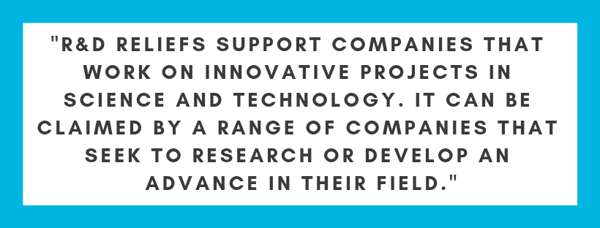
If your business is finding new and innovative ways to create solutions to specific problems and issues, then you don’t want to overlook the potential benefits of HMRC’s R&D tax credits.
It could result in you either receiving money from the government or, saving on your corporation tax bill.
The two common questions we receive when we ask, “Have you considered this tax relief?” is:
The R&D tax relief scheme encourages scientific and technological innovation in the UK. If your business works on qualifying R&D activities you can recover 33.35% of your spend in this area. This is through a cash repayment via tax credits for loss making organisations.
Alternatively, if your business is profitable then the R&D spend is applied as a relief in the form of a reduction to your corporation tax liability. HMRC states:

R&D tax credits aren't limited to any particular industry, or company. Generally if you're doing the following in your business then you may be eligible:
Here’s a helpful list of R&D questions to ask yourself about your business to ascertain if qualify. They're particularly useful because a large number of organisations don’t realise that they are eligible to apply for R&D tax credits.
Often, they either don’t know they can do so, or they're so caught up in the hustle and bustle of building a business. They don't comprehend that they're in the midst of developing a product or service that is uncovering a new solution.
There are 2 different schemes for R&D tax relief. It depends on the size of your business and whether the R&D work was sub-contracted out to you. The 2 schemes are:
1. The SME tax credit scheme
2. The large company scheme
If you think you're eligible for the SME scheme then to qualify you need to meet the following criteria:
It’s important to remember that not all projects and expenditure qualify for a R&D claim. It may be easier for some businesses to identify their qualifying activities than others. This is where robust financial systems and a tax professional with specialist R&D knowledge can help you decipher which activities and costs could qualify.
Whilst not exclusively limited to these sectors, in our experience the following tend to benefit from these claims:
R&D tax credits will add value you to your business, the initial cash benefit alone can help ease the pressure on working capital requirements. As mentioned above, there are two ways R&D tax relief works which means the benefits will differ slightly for different businesses:
For many businesses the confusion lies in not knowing if what they are doing can be considered as an R&D qualifying activity. We can work with you to explore and understand your expenditure, and help identify relevant work undertaken to evaluate if your business is eligible for a potential claim. We can also help you assess the cost benefits to understand whether it's worth having HMRC potentially review your accounts in order to make a claim.
The content of this post was created on 02/10/2018 and updated on 13/05/2021.
Please be aware that information provided by this blog is subject to regular legal and regulatory change. We recommend that you do not take any information held within our website or guides (eBooks) as a definitive guide to the law on the relevant matter being discussed. We suggest your course of action should be to seek legal or professional advice where necessary rather than relying on the content supplied by the author(s) of this blog.
Click below for office location details
LEAVE A COMMENT -